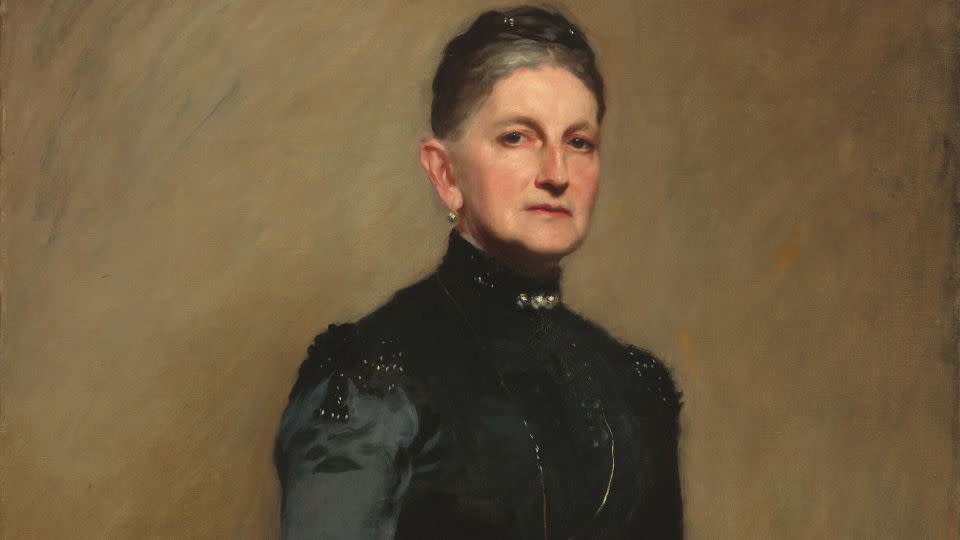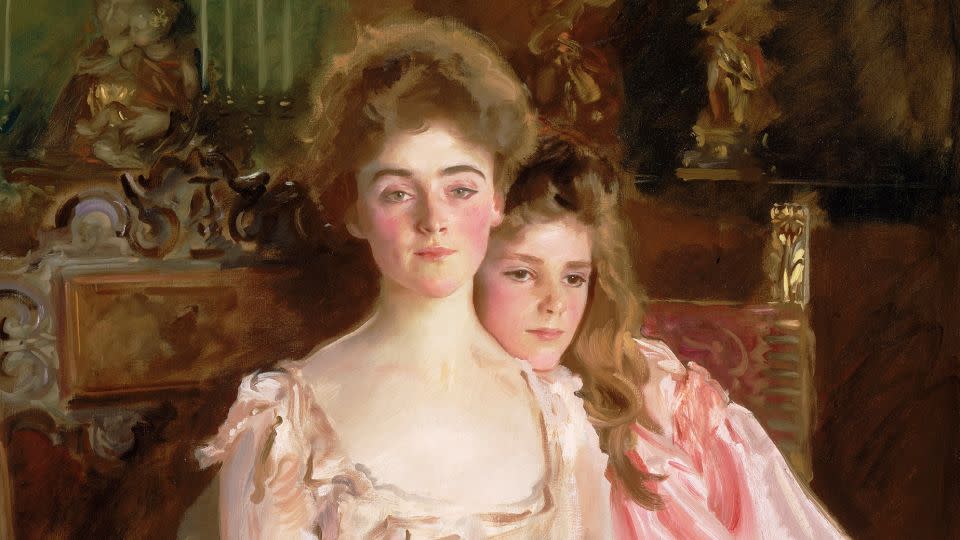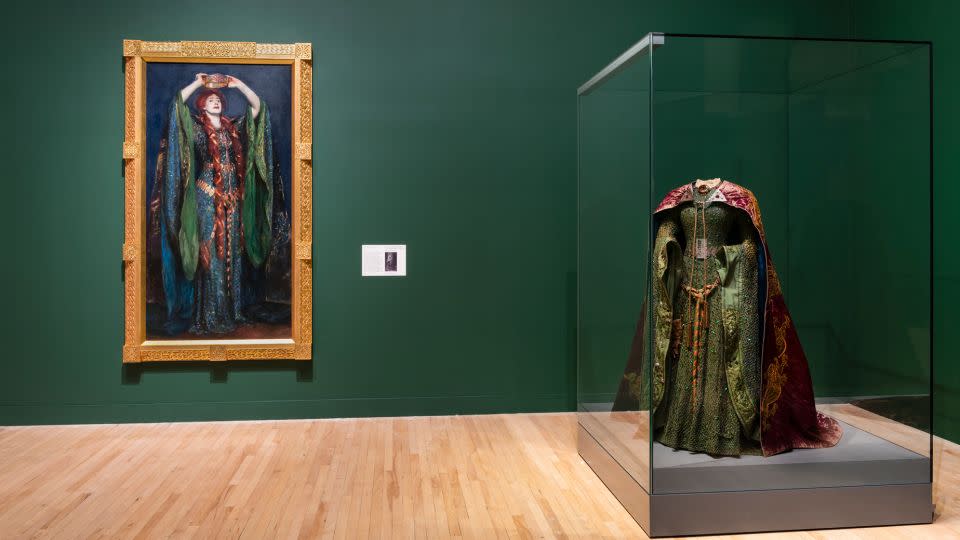Was this 19th century portrait painter also the first celebrity stylist?
- Oops!Something went wrong.Please try again later.
In the spring of 1888, New York socialite Eleanora Iselin welcomed the portrait artist John Singer Sargent into her home, feverish over the question of what she would wear. Eager for her expensive and refined taste to be immortalized on canvas, Iselin instructed a maid to follow her into the drawing room carrying an armful of her best Parisian frocks. To Iselin’s horror, the renowned painter insisted on capturing what she was wearing then and there. No rosy-colored garments, no haute couture ball gown.
The result was a slightly stern, removed portrait — one of the main offerings in “Sargent and Fashion,” a new exhibition on show at the Tate Britain until July 7 — with Iselin rendered in a black satin day dress against a muddy-brown backdrop.
But while she wasn’t reproduced in the French finery she expected, there is a mesmeric beauty in the satin finish of Iselin’s dress, the glinting embellishments of her corset, the protruding ruffles of her white lace sleeves.

“He doesn’t just flatter you. It’s not a servitudinal relationship,” curator James Finch told CNN Style at the London gallery. “It’s a creative one in which each portrait emerges in its own unpredictable way.”
‘Will it paint?’
There have been countless retrospectives on the 19th century painter, examining his characterful high-society portraits or watercolor landscapes, but “Sargent in Fashion” — created in collaboration with Boston’s Museum of Fine Arts — places the 140-year-old artist in a brand new context.
Working during the rise of haute couture, both Sargent and his subjects were living through a new dawn of fashion. “The couturier had more prominence,” said Finch. “And many of the things that we see as hallmarks of the fashion industry nowadays, such as seasonal collections, runways, clothes actually seen on models rather than mannequins, were all being introduced for the first time.”
This new, electrifying sartorial landscape brought with it a widespread preoccupation with clothes that not only influenced Sargeants’ artistic eye, but his clients’ desires too. “There is now a class who dress after pictures, and when they buy a gown ask, ‘Will it paint?’” wrote Scottish critic Margaret Oliphant in 1878. Suddenly, fashion wasn’t only about wealth and status, it was self expression, creativity, art. Designers, lauded for their perspective and skill, transcended the title of “dressmaker” and collected loyal followings. Fashion, as Edith Wharton wrote in 1920, was a powerful form of “armor.”
The artist as stylist
While painting clothing is a skill all portrait artists must master, Sargent’s relationship to his sitter’s outfits is unique. He was controlling, with an insatiable need to curate the entire image — including what his subject was wearing. Colors, textures, fabric finishes and silhouettes were, in Sargent’s mind, central to the portrait’s harmony and therefore could not be left to chance.
He often disregarded the sartorial preference of his sitter, as was the case with poor Iselin, and shaped what was worn (or at least what was seen) carefully. In 1903, Sargent painted mother and daughter, Gretchen and Rachel Warren, at Fenway Court (now known as the Isabella Stewart Gardner Museum) in Boston. The pair sit closely — almost intertwined — with Rachel’s head resting on her mother’s shoulder. Their flushed cheeks are intensified by the pink hue of Rachel’s dress. Only it wasn’t a dress at all. According to the exhibition, the young girl had arrived to sit in an ill-fitting dress of the wrong shade, and instead of making do, Sargent draped a yard of rose-colored fabric around her. By the time the portrait was finished, the scrap of cloth had transformed on the canvas into a diaphanous dress.

“He’s not just documenting what’s in front of him,” Finch told CNN. “He’s inserting himself into (the painting) in a way akin to a stylist or a fashion director.”
Sargent even commissioned the most prominent couture houses of the time to make dresses for his sitters on occasion. For the portrait of close friend Sybil Sassoon in 1922, he enlisted the help of English couturier Charles Fredrick Worth (whose label, House of Worth, was the first haute couture atelier established in Paris in 1858). Worth created a custom black velvet gown and matching cape trimmed with metal thread lace from for Sassoon, with a tall, vampyric mauve collar. Sargent mirrors the dress’s purple accents in the delicate complexion of Sassoon, and again in the small mauve flower in her right hand.
‘A new entry point to the portraits’
Reframing a centuries old master as something new to be discovered is no small feat, either. Renowned paintings such as “Carnation, Lily, Lily Rose” (1885-86) — which is usually displayed in a darker, red corner of the gallery — are recontextualized against a soft periwinkle display wall designed to amplify the painting’s dwindling evening light.
Similarly, with the help of the Boston Museum of Fine Arts textile department, many of the works on show are paired with their original gown. And although Sybil Sassoon’s brooding black taffeta opera cloak looks somewhat flat compared to its five-foot illustrative counterpart, the dressed mannequins act as three dimensional portals into Sargent’s world.
“It provides you with a new entry point to the portraits,” said Finch. “You see these garments in front of you and you think about who wore them, how the dresses have survived, and how they’ve been passed down through generations from mother to daughter, and the stories about how the dresses were often adjusted to fit changing body sizes. I think all of that’s really relatable.”

‘Their work was ready-to-wear. Sargent was bespoke’
But not everyone was pleased about the reassessment of Sargent’s ouevré. During opening week, one British art critic called it a “horrible exhibition” that was “crowded by old clothes.” Finch disagrees. “Showing Sargent’s work in relation to garments doesn’t take away from any of the previous research done on him,” he told CNN.
In fact, the exhibition suggests Sargent’s famed ability to capture entire inner worlds through the shadow of a facial expression was enhanced, not stifled, by his evident interest in clothes. For example, reckoning internally with what she likely considered to be a fashion emergency, we glean so much more about Iselin’s character than had Sargent let her wear whatever she wanted.
“A lot of Sargent’s contemporaries fell back on formalism,” said Finch. “Their work was ready-to-wear, using off the (rack) elements of portraiture, whereas with Sargent it always was bespoke. Each portrait was different.”
For more CNN news and newsletters create an account at CNN.com

